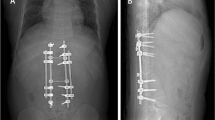Abstract
Introduction
Chronic herniation syndromes other than tonsillar herniation are not well-recognized. Transtentorial uncal herniation in its chronic form has been reported in only few case reports (Horowitz et al., J Neuroimaging 12:78–79, 2002; Naidich et al., Radiology 158:431–434, 1986; Ng and Valiante, J Clin Neurosci 16:944, 2009; Ng and Valiante, J Clin Neurosci 16:984, 2009). We hereby illustrate a case with this rare finding, including MR imaging, and analyze this phenomenon.
Case report
A 15-year-old girl had a resection of a cerebellar pilocytic astrocytoma at 5 years of age. Two months later, she underwent a cystoperitoneal shunt for persistent headache and pseudomeningocele, secondary to an enlarging cyst at the tumor bed. Subsequently, her shunt was upgraded to a more conservative valve following clinical evidence of over drainage. This was also associated with imaging compatible with bilateral uncal herniation. After the procedure, she had relief of symptoms.
Conclusion
We conclude that a negative pressure gradient in the posterior fossa, relative to the supratentorial compartment, is the etiology of the chronic uncal herniation in our patient. Comparing the case reports in the literature with our case, we postulate that chronic uncal herniation is a complication of shunting of a posterior fossa fluid cavity in children, many of them with Dandy–Walker syndrome and/or other cerebellar cystic formations. The treatment priority at presentation should be to rule out shunt malfunction. In the event of association with clinical over-drainage syndrome, there may be a role for changing the shunt system into a more conservative drainage combination.




Similar content being viewed by others
References
Meyer A (1920) Herniation of the brain. Arch Neurol Psychiatry 4:387–400
Agarwal D, Durity FA (2006) Seizure as a manifestation in a shunted patient. Pediatr Neurosurg 42:165–167
Chumas PD, Armstrong DC, Drake JM, Kulkarni AV, Hoffman HJ, Humphreys RP et al (1993) Tonsillar herniation: the rule rather than the exception after lumboperitoneal shunting in the pediatric population. J Neurosurg 78:568–573
Lay CM (2002) Low cerebrospinal fluid pressure headache. Curr Treat Options Neurol 4:357–363
Horowitz M, Kassam A, Levy E, Lunsford LD (2002) Misinterpretation of parahippocampal herniation for a posterior fossa tumor: imaging and intraoperative findings. J Neuroimaging 12:78–79
Komotar RJ, Mocco J, Ransom ER, Mack WJ, Zacharia BE, Wilson DA et al (2005) Herniation secondary to critical postcraniotomy cerebrospinal fluid hypovolumia. Neurosurgery 57:286–292
Mohanty A, Biswas A, Satish S, Praharaj SS, Sastry KV (2006) Treatment options for Dandy–Walker malformation. J Neurosurg 5:348–356
Naidich TP, Radkowsky MA, McLone DG, Leetsma J (1986) Chronic cerebral herniation in shunted Dandy–Walker malformation. Radiology 158:431–434
Niedermuller U, Trinka E, Bauer G (2002) Abducent palsy after lumbar puncture. Clin Neurol Neurosurg 104:61–63
Paldino M, Mogliner AY, Tenner MS (2003) Intracranial hypotension syndrome: a comprehensive review. Neurosurg Focus 15:1–8
Shim KW, Lee YH, Park EK, Park YS, Choi JU, Kim DS (2009) Treatment option for arachnoid cysts. Childs Nerv Syst 25:1459–1466
Ng WH, Valiante T (2009) An unusual parahippocampal lesion presenting with seizures. J Clin Neurosci 16:944
Ng WH, Valiante T (2009) An unusual parahippocampal lesion presenting with seizures. J Clin Neurosci 16:984
Wolfe SQ, Bhatia S, Green B, Ragheb J (2007) Engorged epidural venous plexus and cervical myelopathy due to cerebrospinal fluid overdrainage: a rare complication of ventricular shunts. J Neurosurg 106:227–231
Yüceer N, Mertol T, Arda N (2007) Surgical treatment of 13 pediatric patients with Dandy–Walker syndrome. Pediatr Neurosurg 43:358–363
Author information
Authors and Affiliations
Corresponding author
Rights and permissions
About this article
Cite this article
Udayakumaran, S., Ben Sira, L. & Constantini, S. Chronic uncal herniation secondary to posterior fossa shunting: case report and literature review. Childs Nerv Syst 26, 267–271 (2010). https://doi.org/10.1007/s00381-009-1027-z
Received:
Published:
Issue Date:
DOI: https://doi.org/10.1007/s00381-009-1027-z




